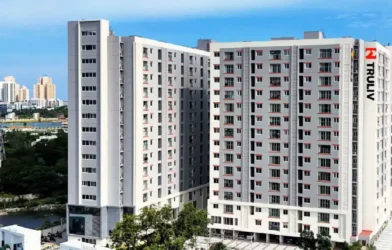Subtotal ₹0.00
Propelled by structural forces of urban expansion, infrastructure development, demographic shifts, digital transformation and increasing focus on technology and sustainability, the Indian real estate sector is set for fast paced long-term growth across asset classes.
According to a recent Colliers-Credai report, the real estate sector is set to unlock new dimensions of opportunity, innovation and resilience to charter a more balanced, equitable and inclusive growth path beyond established tier-1 cities with its rapid expansion into tier 2-3 cities.
On a transformative path from a largely fragmented sector to a more organized and strategic contributor of nation development, real estate in the upcoming decades is likely to be characterized by quantum growth fuelled by rising institutionalization amidst strong investor appetite and scaling up of demand. Overall, real estate will become a more prominent force in India’s economic growth story, with the substantial scaling up of core segments like office, residential, industrial & warehousing and retail by 2047. The realty sector has the potential to reach USD 10 trillion mark, contributing to almost 20% of India’s GDP.
Trends in real estate asset classes of India –
| Real estate segment | Parameter | Units | 2000 | 2010 | 2020 | 2025E | 2030F | 2047F | |
| Core asset classes | Office | Stock | Bsf | ~0.03 | ~0.3 | ~0.6 | 0.8+ | 1.0+ | 2.5-3.0 |
| Residential | Housing units sold | Million | <0.1 | ~0.3 | 0.1-0.2 | 0.3-0.4 | 0.5-0.6 | 0.8-1.0 | |
| Industrial & warehousing | Stock | Bsf | ~0.01 | ~0.02 | ~0.1 | ~0.3 | ~0.5 | 2.0+ | |
| Retail | Malls | Number | ~3 | >300 | >500 | 750+ | 1,000+ | 1,500+ | |
| Alternate asset classes | Data centers | Colocation Capacity | GW | <0.01 | ~0.1 | ~0.5 | 1.3 | ~4.5 | 10-15 |
| Co-living | Beds | Million | – | – | 0.2 | 0.3 | 1.0 | 3.0+ | |
| Senior living | Beds | Million | – | – | <0.01 | 0.03 | ~0.1 | 1.0+ |
Source: Colliers
Note: Bsf- Billion sq ft | E- Estimated | F- Forecast | Data pertains to Grade A buildings only for office and Industrial & warehousing segments | Top cities in office and data centers segment include-Bengaluru, Chennai, Delhi NCR, Hyderabad, Kolkata, Mumbai, Pune; Top cities in Industrial & warehousing and residential segment include-Ahmedabad, Bengaluru, Chennai, Delhi NCR, Hyderabad, Kolkata, Mumbai, Pune
The office real estate journey has been quite spectacular with Grade A office stock surging over 3 times since 2010 to more than 800 million sq ft currently, driven by accelerated demand from both Global Capability Centers (GCCs) and domestic players across segments such as technology, BFSI, engineering & manufacturing etc. Traction in flex spaces too has added to the vibrancy of India’s office market. Grade A stock levels on the industrial and warehousing front, surpassed 250 million sq ft mark in 2025, growing multifold compared to 2010 levels, amidst robust infrastructure development, private sector participation and evolving consumer demand as well as warehousing requirements. Driven by increasing institutionalization, demand scale-up and strong economic growth prospects, overall stock in both these segments is likely to exceed 2 billion sq ft by 2047.The share of REITs in real estate market capitalization is likely to surge from 16% in 2025 to 40-50% by 2047, with the share in office market as high as 60%.
The urban migration driven by IT in 2010 decade onwards, led to a surge in demand for housing across Tier I cities of the country. Furthermore, the Real Estate (Regulation & Development) Act (RERA) brought in the much-needed transparency & accountability. Although housing sales took a hit in the immediate aftermath of the COVID-19 pandemic, the segment bounced back subsequently on a stronger footing — evident by record breaking sale volumes in recent years. With a significant portion of the workforce entering the prime earning stage in the coming years, supported by expected rise in income levels and progressive housing policies, annual housing sales could potentially double to 1 million units by 2047.
Real estate segments like retail, hospitality and alternatives like data centers, senior living, and co-living too have picked up pace backed by demographic shifts, increase in disposable income and rapid digitalization. For instance, data center capacity in India has grown over 2.5X times to around 1,300 MW as on date. Penetration rates in co-living and senior living sub-segments too have increased significantly in the last few years.
In the coming years, developers are likely to increasingly focus on real estate segments beyond office, residential and industrial & warehousing. Retail and hospitality segments particularly are expected to witness accelerated growth in the smaller cities, having high untapped potential. Moreover, the quantum growth in data centers and shared living facilities such as co-living and senior living will be driven by the changing needs of a digitally empowered and demographically diverse population.
The ascendancy of Indian economy and growth of real estate is likely to continue further driven by policy support and pivotal growth ingredients such as infrastructure development, rapid urbanization and adoption of climate resilient features in built structures etc.Indian cities are urbanizing rapidly, with nearly 900 million people—53% of the population projected to live in urban areas by 2050, up from the current levels of 37%. To accommodate this growth, urban development needs to expand beyond the established Tier I cities into smaller Tier II & III cities and emerging growth corridors as well.This is a sure recipe for unprecedented growth of the real estate sector, which has a growth potential of USD 10 trillion particularly as Indian economy is set to emerge as the third largest economy in the world by 2030.













